Motion and Measurement of Distances Class 6 Extra Questions Science Chapter 10
NCERT Extra Questions for Class 6 Science Chapter 10 Motion and Measurement of Distances
Story of transport
Question 1.
Name the invention which made a great change in modes of transport.
Answer:
Invention of wheel.
Question 2.
Which power was used to pull vehicles in ancient times?
Answer:
Animals were used to pull vehicles in ancient times.
Question 3.
Define rest and motion.
Answer:
An object that does not change its positions with time is said to be at rest.
An object that changes its positions with time is said to be in motion.
How far have you travelled? How wide is this desk?
Question 1.
Why is it important to know how far a place is?
Answer:
It is important to know how far a place is, so that we can have an idfea how we are going to reach that place – walk, take a bus or train, a ship, an aeroplane or even a spacecraft. ‘
Question 2.
What does your P.T. teacher use to measure the length of the playground?
Answer:
My P.T. teacher has plastic made tape scale to measure the length. Its total length is 100 metre. It can be rounded up in round box.
Question 3.
What is estimation?
Answer:
To guess the dimensions of an object without actual measuring is known as estimation. It is difficult to make near about correct estimate. It needs a lot of experience.
Question 4.
Explore and find out what kind of scale is used by cloth merchants, tailors, carpenters and mechanics to measure length.
Answer:
Cloth merchants use iron/steel metre scale.
Tailors use plastic metre scale tape.
Carpenters use plastic metre tape and iron metre scale both.
Question 5.
Differentiate between distance and displacement.
Answer:
Distance: The total length travelled from one point to another.
Displacement: It is the shortest distance travelled from one point to another.
Some measurements
Question 1.
What is measurement?
Answer:
Measurement is the technique developed for correct judgement of dimensions of various objects.
Question 2.
What do you understand by unit?
Answer:
A quantity adopted as a standard of measurement of a physical quantity is called unit.
Question 3.
Name the two parts which must be mentioned to state the results of a measurement.
Answer:
Magnitude and unit are the two parts which must be mentioned to state the results of a measurement.
Question 4.
What type of measuring device would you use to measure the girth of a tree?
Answer:
Measuring tape is suitable to measure the girth of a tree.
Standard units of measurements
Question 1.
What is the system used for measurements nowadays?
Answer:
S.I. system.
Question 2.
Name the unit of length, which should be used to express the thickness of a coin.
Answer:
Millimetre (mm).
Question 3.
Name the unit of length, which you would like to use while expressing the distance between Delhi and Lucknow.
Answer:
Kilometre (km).
Question 4.
Name the SI unit of length.
Answer:
Metre (m).
Question 5.
What is the convenient unit to measure the distance between two cities or villages?
Answer:
Kilometre (1 km = 1000 m).
Question 6.
Which unit should be used to express thickness of coin or wire?
Answer:
Very small length like thickness of coin or wire is expressed in millimetres (mm).
1 mm = 10-3 m or 103 mm = 1 m.
Question 7.
Why a cubit cannot be used as the standard unit of length?
Answer:
Length of hand and cubit are not same for all the people. So these cannot be used as the standard unit of length.
Question 8.
Define cubit and foot.
Answer:
Cubit is the length between the tip of the elbow and the middle finger.
The length of the foot of a person is called foot.
Question 9.
Fill in the blanks:
(a) 1 cm = …………… mm.
(ft) 1 dm = ………….. metre.
(c) 1 kilometre = …………… metre.
(d) 1 metre =……………….. centimetre.
Answer:
(a) 10
(b) 1/10
(c) 1000
(d) 100
Question 10.
Fill in the blanks with < or > sign.
(a) 1 decametre ………………1 decimetre.
(b) 1 millimetre ………………1 centimetre.
(c) 1 hectometre ………………1 kilometre.
(d) 1 decimetre ………………1 centimetre.
Answer:
(a) 1 decametre > 1 decimetre.
(b) 1 millimetre < 1 centimetre.
(c) 1 hectometre < 1 kilometre.
(d) 1 decimetre > 1 centimetre.
Correct measurement of length
Question 1.
List three uses of metre.
Answer:
Metre can be used as a unit to measure
- the length of a room
- the height of a tree or a building or
- the length and breadth of a playground.
Question 2.
Can you measure the length of a pencil with metre-scale?
Answer:
No, length of pencil cannot be measured with metre scale. To measure the length of a pencil, a small scale, like six inches plastic scale should be used. This length should be expressed in centimetres.
Question 3.
A 30 cm scale has one end broken. The mark at the broken end is 2.6 cm. How would you use it to measure the length of your pencil?
Answer:
Put one end of the pencil at nearest full mark say 3.0 cm in this case. Take the reading of the other end. Now subtract 3 from the previous reading and this will be the required length of pencil.
Question 4.
State two precautions, which should be taken while using a metre scale to measure the length of an object.
Answer:
Two precautions are:
- Place the scale in contact with the object along its length.
- Most important, eye should be correctly positioned above the point to be measured to make a correct measurement.
Question 5.
Describe the method you would use to find the thickness of a sheet of paper of your science book.
Answer:
It is not easy to measure the thickness of a single sheet of paper by using metre scale. The method used to find the thickness of a single sheet is as follows:
Take 100 sheets of paper together. Find their combined thickness by using a centimetre scale. Divide the total thickness by the number of sheets. It is the thickness of a single sheet.
For example: If the thickness of 100 sheets = 1.5 cm.
Thickness of a single sheet
![]()
= 0.015 cm.
Question 6.
What precaution should be taken while buying something?
Answer:
While buying clothes, pipes, laces, it should be checked whether the scale is correct or not. A correct metre has signs (⟷) on both the ends in addition to the stamp of the weight and measure department. The metre scale may have been cut off. In such a case short measurement is resulted.
Question 7.
Can you measure the diameter of a ball with the help of metre scale?
Answer:
Yes, the diameter of a ball can be measured correctly with the help of metre scale. It is one of the ways in which diameters of spherical surface can be measured easily. In this method, the two wooden blocks A and B must be exactly parallel to each other (Fig. 10.11).

Question 8.
How will you find the thickness of a thin wire?
Answer:
Take a round pencil and wrap the given wire round the pencil making 25 turns forming a coil. Measure the length of the so formed coil. Divide the total length of the coil by number of turns. This is the thickness of the wire.
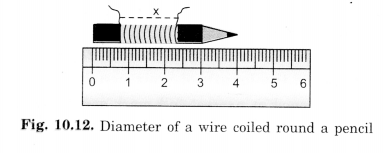
Question 9.
How would you measure the thickness of a coin?
Answer:
Take ten coins and put them one over another. Find the total thickness of ten coins with the help of a scale. Divide the total thickness by the number of coins (Fig. 10.13).
![]()
=0.24 cm

Measuring the length of a curved one
Question 1.
Which device we can use to measure the length of a curved line?
Answer:
Thread.
Question 2.
Using a thread how will you find the circumference of a one-rupee coin.
Answer:
Firstly, fix one end of the thread, place the coin adjacent to that point, roll the thread exactly once around the coin. Then find the length of the thread by using a scale, which is the required circumference of the coin.
Moving things around us
Question 1.
Is the hour hand of a wall clock at rest or in motion?
Answer:
The hour hand of the wall clock is in motion because it is changing its position.
Question 2.
Is your classroom at rest or in motion?
Answer:
Our classroom is said to be at rest according to the definition of motion.
Question 3.
If you are sitting in a moving bus, are you at rest or in motion?
Answer:
If we are sitting in a moving bus, we are not changing our position in comparison to things inside the bus. According to the definition of motion, we are not moving. The bus is moving. In other words, we can say that we are in motion in comparison to outside trees and other buildings and stationary in comparison to things inside the bus.
Question 4.
Group the following into moving and stationary objects:
- House top
- Clock
- Minute hand of the clock
- Bird sitting on the roof
- Flying bird
- Table.
Answer:
| Moving objects | Stationary objects |
| Minute hand of the clock, Flying bird | House top, clock, Bird sitting on the roof, Table |
Types of motion
Question 1.
What is circular motion?
Answer:
Movement of an object along a circular path is called circular motion. Direction of moving body always changes in circular motion. For example, the moon moves around the earth, the earth moves around the sun. Bull is moving around a central pole (See Fig. 10.5).
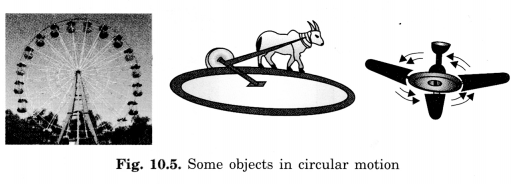
Question 2.
Define rotatory motion with a suitable example.
Answer:
The motion in which a body moves along a circular path about a fixed point or axis without changing its position is called rotatory motion. For example, Potter’s wheel and the spinning top.
Question 3.
Define periodic motion.
Answer:
The motion which repeats after a regular interval of time is called periodic motion. For example, motion of tip of arm of a clock and motion of a swing are periodic motions. Motion of the earth and the moon (Fig. 10.8).
Question 4.
How will you measure the length of any curved line?
Answer:
To measure the length of curved lines we have to use divider. Let there be a curved line AB (Fig. 10.14). Open the legs of the divider to cover some convenient distance, say 5 mm. Place one leg of the divider at one end of the curved line. Put the other leg on the line. Now count the number of times the divider has to be taken along the line to cover the entire length of line AB. At the end, some portion of line may be left out, being less than the distance between the two legs. Measure it separately by adjusting the divider. Multiply the number of complete steps by the distance between the two legs. Add the length of the remaining distance to this length. You will get the total length of curved line.
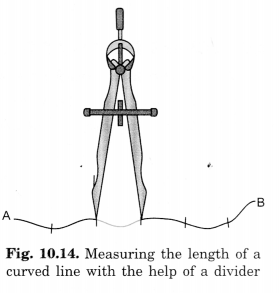
Question 5.
Fix a rubber string or a piece of a thread stretched between the nails. Pluck it just like the string of a Sitar or a Violin. What type of motion is this?
Answer:
The motion of a string or a thread in this case is an oscillatory motion, a type of periodic motion.

Question 6.
Observe the following figures and state which type of motion is that?

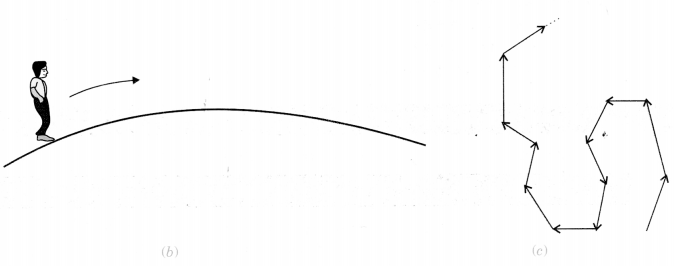
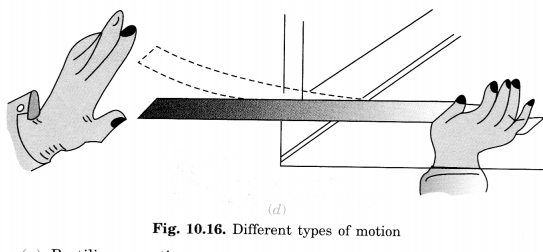
Answer:
(a) Rectilinear motion.
(b) Curvilinear motion.
(c) Random motion.
(d) Vibrational motion (a kind of Periodic motion).
Question 7.
What is translatory motion? What are its types?
Answer:
The motion in which a body moves as a whole and every point on it moves the same distance is called translatory motion.
Translatory motion is of three types:
(i) Linear motion
(ii) Curvilinear motion
(Hi) Random motion.
Question 8.
Give examples of periodic and oscillatory motions.
Answer:
Examples of periodic motion are:
- motion of moon around the earth
- heart-beat in a healthy person
- motion of earth around the sun
Examples of oscillatory motion are:
- motion of pendulum of wall clock
- a child on a swing
- motion of heart muscles in a healthy person.
Objective Type Questions
Question 1.
Match the following items given in Column A with that in Column B:
| Column A | Column B |
| (a) Metre | (i) Unit used to measure very small distances. |
| (b) Yard | (ii) Unit used to measure large distances. |
| (c) Hand span | (iii) SI unit of length. |
| (d) LeaSt count | (iv) Non-standard unit of length. |
| (e) Millimetre | (v) Standard unit of length. |
| (f) Kilometre | (vi) Apple falling from a tree. |
| (g) Rest | (vii) Motion of the tip of the blade of a fan. |
| (h) Motion | (viii) Motion of a pendulum. |
| (i) Circular motion | (ix)Motion of a top. |
| (j) Rectilinear motion | (x) State of moving objects. |
| (k) Rotational motion | (xi) State of stationary objects. |
| (l) Periodic motion | (xii) Minimum amount that can be measured by a device. |
Answer:
| Column A | Column B |
| (a) Metre | (iii) SI unit of length. |
| (b) Yard | (v) Standard unit of length. |
| (c) Hand span | (iv) Non-standard unit of length. |
| (d) LeaSt count | (xii) Minimum amount that can be measured by a device. |
| (e) Millimetre | (i) Unit used to measure very small distances. |
| (f) Kilometre | (ii) Unit used to measure large distances. |
| (g) Rest | (xi) State of stationary objects. |
| (h) Motion | (x) State of moving objects. |
| (i) Circular motion | (vii) Motion of the tip of the blade of a fan. |
| (j) Rectilinear motion | (vi) Apple falling from a tree. |
| (k) Rotational motion | (ix)Motion of a top. |
| (l)Periodic motion | (viii) Motion of a pendulum. |
Question 2.
Fill in the blanks with appropriate words:
- Striker in the game of carroms moves in a …………. .
- Powerful shot by a batsman makes the ball move in ………….. motion.
- Moving ceiling fan is an example of …………… motion.
- Rotational motion is known as ………….. motion also.
- …………….. motion is also a periodic motion.
- Invention of…………. made great change in modes of transport.
- Measurement means the comparison of an ………………….. quantity with some ……….. quantity of the same kind.
- It was the …………………. who developed the ‘foot’ as their unit of length.
- In 1790, the French created a standard unit of measurement called the ……….. system.
- System of units now used is known as ……………… system.
- Each metre is decided into 100 equal divisions, called ……………. .
- Each centimetre has ………………. equal divisions called millimetre.
- Motion is the change in …………….. of an object.
- Motion of a branch of tree is …………….. motion.
- A ball rolling on ground executes a rectilinear motion as well as ……………. motion.
Answer:
- straight line
- rectilinear
- circular
- periodic
- Oscillatory
- wheel
- unknown, known
- Greeks
- metric
- S.I.
- centimetre
- ten
- position
- periodic
- rotational
Question 3.
State whether the statements given below are True or False:
- Swinging of our arms or legs are periodic motions.
- Beating of our heart is non-periodic motion.
- Periodic motion helps us to measure time.
- In a circular motion; the objects or any of their parts move in a circular path.
- Motion of second’s hand of a clock is rectilinear.
- SI unit of length is ‘Foot’.
- For measuring large distances metre is not a convenient unit.
- Motion of a vehicle on a straight road is a rectilinear motion.
- Marchpast of soldiers in a parade is a periodic motion.
- Motion of second’s hand in a clock is a circular motion.
- In rotational motion whole body moves about an axis.
- The result of a measurement is expressed in two parts.
Answer:
- False
- True
- True
- True
- False
- False
- True
- True
- False
- True
- True
- True
4. Choose the correct option in the following questions:
(i) Which is a standard unit of measurement?
(a) Angul (finger)
(b) Mutthi (fist)
(c) Step
(d) Inch
Answer:
(d) All other units vary from person to person,
(ii) What is the SI unit of length?
(a) Metre
(b) Centimetre
(c) Kilometre
(d) All of these
Answer:
(a) All other are multiples of metre.
(iii) 4 kilometres are equal to
(a) 4,00,000 metre
(b) 40,000 metre
(c) 4,00p metre
(d) 400 metre
Answer:
(c) 1 km = 1000 m, 4 km = 4000 m
(iv)15 cm are equal to
(a) 150 mm
(b) 15 mm
(c) 1.5 mm
(d) 0.15 mm
Answer:
(a) 1 cm = 10 mm, 15 cm = 150 mm
(v) Which is a correct relationship?
(a) 1 m = 100 cm
(b) 1 cm = 100 mm
(c) 1 km = 100 m
(d) all of these
Answer:
(d) 1 m = 100 cm.
(vi) In the following figure, the proper way of reading scale is
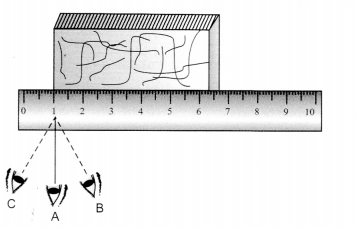
(a) C
(b) B
(c) A
(d) Any way can be choosen
Answer:
(c) B and C are incorrect positions.
(vii) An example of rectilinear motion is
(a) apple falling from a tree
(b) motion of a car on road
(c) a spinning top
(d) both (a) and (b)
Answer:
(d) Apple falling from a tree and motion of a car on road are the examples of rectilinear motion.
(viii) Which is an example of a periodic motion?
(a) Oscillation of a pendulum
(b) Motion of a bus on road
(c) A spinning top
(d) A stone dropped from a certain height
Answer:
(a) Oscillation of a pendulum is an example of periodic motion.
(ix) What kind of motion is executed by a pendulum of a wall clock?
(a) Oscillatory motion
(b) Vibratory motion
(c) Circular motion
(d) Linear motion
Answer:
(а) The to-and-fro motion of a body along the same path is called oscillatory motion.
(x) One metre is equal to ………….. millimetre.
(a) 10
(b) 1000
(c) 100
(d) 10000
Answers
(b) 1 metre = 1000 millimetre.
Extra Questions for Class 6 Science
<!–
–>